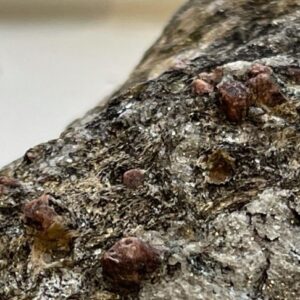Garnet Schist is a gray, silvery, or brown-colored metamorphic rock with layers of shiny mica and well-formed Garnet crystals. If you’ve seen Mica Schist before then you’ve seen Garnet Schist because the only difference is the Garnets. From time to time, readers will ask me what the parent rock is and it’s usually Shale, Mudstone, or Felsic igneous rock.
The major minerals found in Schist are Mica and Quartz. During the compression of the rocks (metamorphism), the thin and flat Mica grains get squeezed into sheet-like layers. This process gives the stones a shiny appearance. The texture of Schist is typically fine-grained. However, with Garnet Mica Schist, the Garnet crystals are large enough to be seen by the naked eye and appear to be floating in the host rock.

Types of Garnet Mica Schist
There are quite a few varieties of Schist, each being named for the dominant mineral found in the rock. For instance, you can find Mica Schist, Green Schist, Biotite Schist, Actinolite Schist, and Garnet Schist.
Garnet Chlorite Schist
Chlorite stones are typically green in color and often lend this beautiful hue to the rocks in which they’re contained. Chlorite Schists are, therefore, characteristically olive or jade-like in color. Because of the green shades, they are referred to as Greenschists in some areas.
Garnet Chlorite Schist will contain chunks of beautifully red-colored Garnet gemstones that appear to be floating within the Greenschist.
Garnet Schist Metamorphic Rock
Garnet Schist is a variation of Mica Schist. It is a metamorphic rock formed by medium-grade metamorphism. It is usually a combination of heat and pressure applied to the original stone – often mud, clay, or shale.
Some Garnet Mica Schist specimens are primarily composed of Muscovite Mica, with minor occurrences of Feldspar and Quartz. However, the stones will also exhibit the presence of numerous Garnets that are visible red crystals growing out of the rock. These types of Garnets are known as porphyroblasts, suggesting that the environment formation was at or in close proximity to a convergent plate boundary with medium-grade regional metamorphism occurring naturally. The Garnets are stronger than the other crystals. So in some instances, it will appear as if the Garnets are pushing the Mica crystals around it, which can be seen much more easily in cut and polished or lacquered specimens.

Garnet Staurlite Schist
Staurolite is a regional metamorphic mineral that’s intermediate to high-grade. The mineral occurs with Micas, Kyanite, Albite, Biotite, Almandine Garnet, and Sillimanite in Gneiss and Schist of regional metamorphic rock. Staurolite is relatively weather-resistant but might alter to Chlorite, Limonite, and Sericite.
When Stauralite is combined with Garnet and Schist to create Garnet Sauralite Schist, you have a metamorphic rock with a foliated texture that is fine to medium-grained. The colors can be medium silver to gray with large dark-brown Staurolite crystals visible, as well as bits of Garnet.

How Is Garnet Schist Formed?
Garnet Schist is a somewhat rare foliated metamorphic rock that forms when the oceanic crust rubs against the overriding plate as it subducts at subduction zones. The metamorphism is caused by intense pressure but relatively low heat, which can give specimens a strange weak foliation.
Metamorphic rocks – meta meaning change and morphos meaning form – are one of the three rock categories in the rock cycle. Metamorphic rock materials have been changed by pressure, temperature, and/or fluids. The rock cycle shows us that both sedimentary and igneous rocks can transform into metamorphic rocks. While metamorphic rocks themselves can be re-metamorphosed. Because metamorphism is caused by plate tectonic motions, metamorphic rocks provide geologists with a rich history of how past tectonic processes shaped the Earth.
Metamorphism happens when solid rocks change in composition and/or texture without the mineral crystals melting – in this case, the crystals are Garnet, which is how igneous rocks are generated. Metamorphic source rocks are called protolith or parent rock. Proto means first, and lithos means rock. Most metamorphic processes occur deep underground, within the Earth’s crust. During metamorphism, protolith chemistry is mildly changed by increased heat, a type of pressure called confining pressure, and/or chemically reactive fluids. Rock texture changes by confining pressure, heat, and a kind of pressure called directed stress.
Garnet Schist Value
Garnet Mica Schist is fairly inexpensive unless you have a perfect Garnet crystal on the host rock. A specimen collector would be willing to pay a premium for this type of specimen but most Garnet Schist is of lower quality and fairly common.
Just remember, the larger and more profound the Garnet, the more money you can expect to receive or pay, depending on which end of the deal you’re on.
- Identify Enstatite - March 12, 2024
- Identify Cerussite - March 3, 2024
- Identify Bytownite - February 18, 2024
